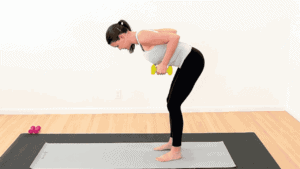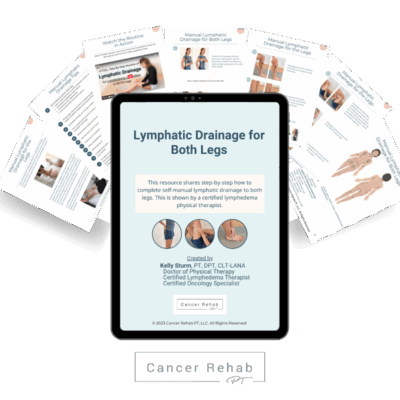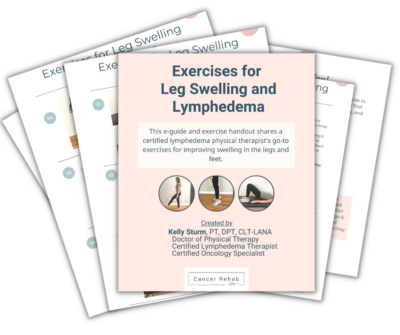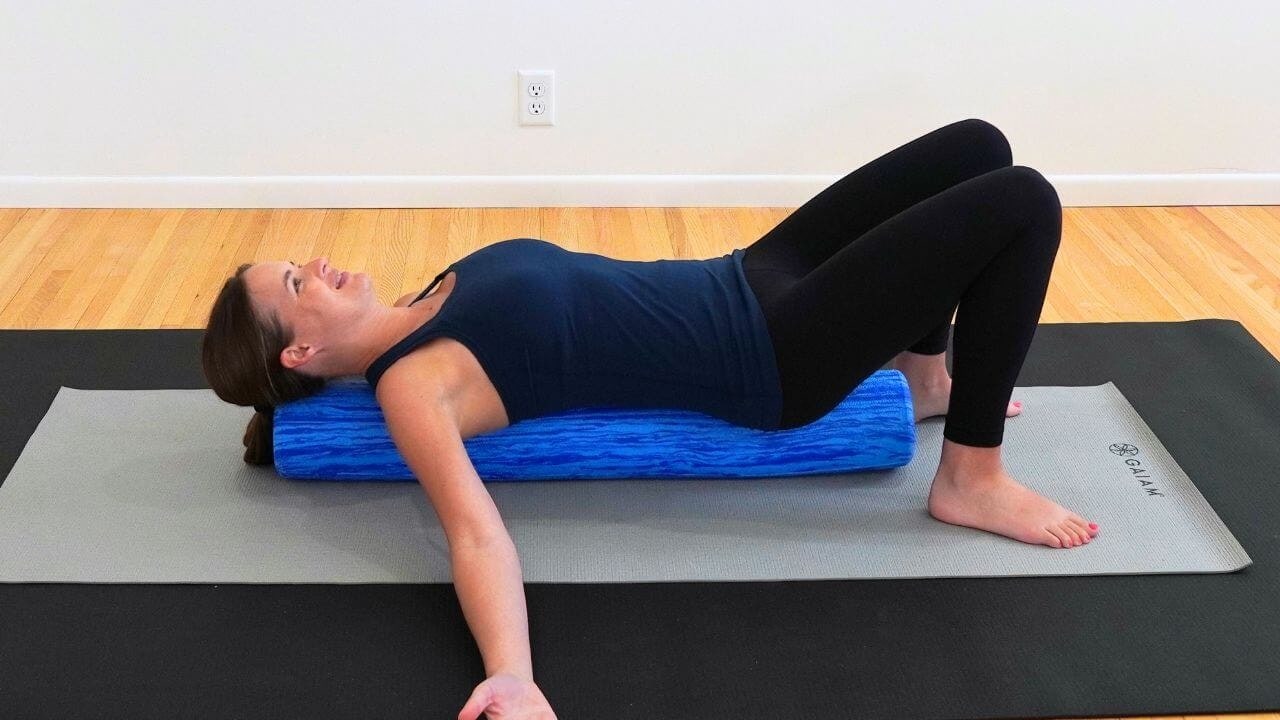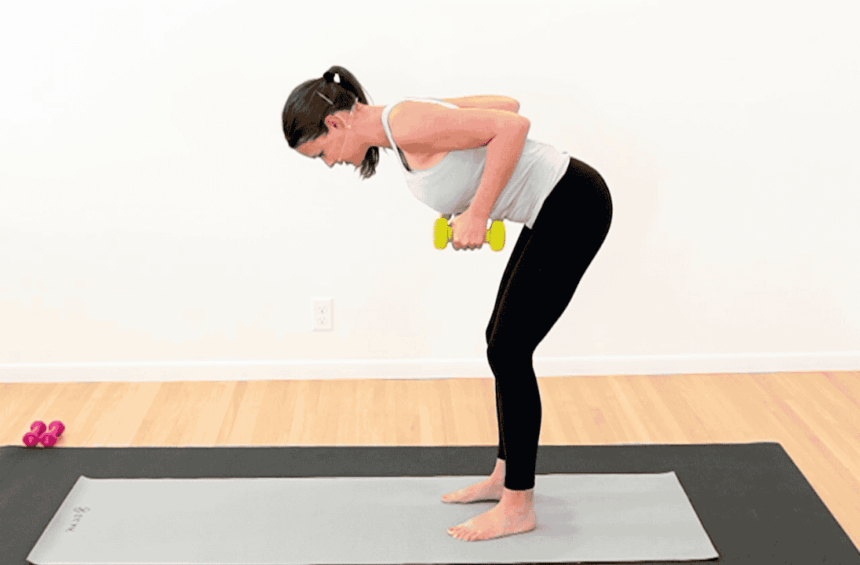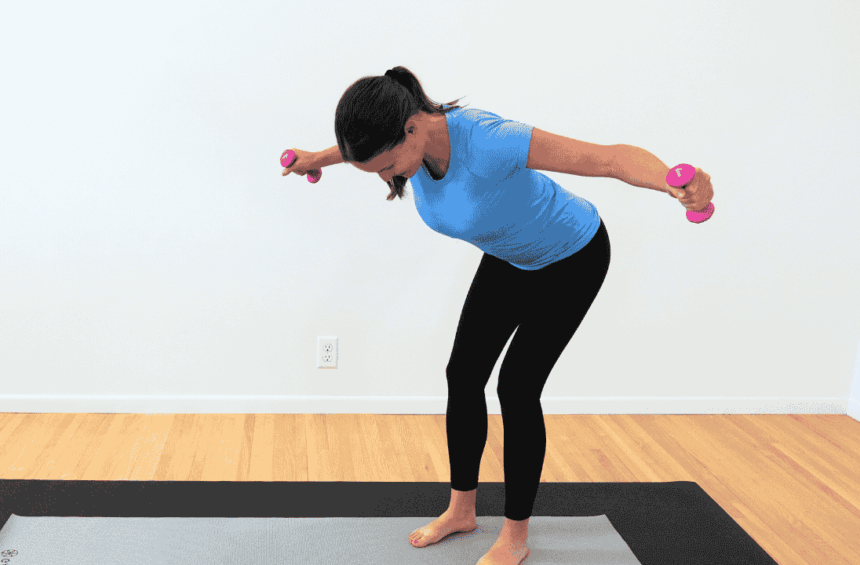Recovering from breast cancer surgery can feel like such a long road. You might be wondering where to start with exercise and when you’ll finally feel like yourself again. I know how frustrating it can be when you want to get moving but aren’t sure what’s safe.
My name is Kelly, and I’m a certified oncology and lymphedema therapist who specializes in helping people recover from breast cancer. I’ve worked with thousands of patients through this exact phase of recovery.
It can take weeks to months, or even longer, to feel like you’re getting back to your normal life after breast cancer treatment. Here I am sharing my go-to gentle exercises for 9 to 12 weeks after surgery to help ease pain, improve tightness and stiffness, and start building strength again.
These exercises can only be done as long as someone is cleared by their doctor or breast care nurse for safety, because everyone has a different surgery and recovery experience.
This guide is part of a series on breast cancer recovery. If you are in the earlier stages of recovery, either with drains still in place or drains recently removed, make sure to begin with Early Exercises After Breast Cancer Surgery: 0-3 Weeks. Those in the middle of their recovery may find Safe Breast Cancer Exercises After Surgery: 4 to 8 Weeks helpful.
Ready for the next steps? Download my free Breast Recovery Roadmap for all 8 phases.
Exercises After Breast Cancer Surgery (9-12 Weeks)
We are going to go through 3 stretching exercises that focus on improving range of motion and decreasing tightness after surgery, plus 3 gentle strength exercises to start getting muscles activating again to help with the pain. All exercises should remain mild without significant pain or strain.
The good news is that exercise helps increase movement after surgery, and these gentle movements are safe to do daily as long as your doctor has cleared you.
These exercises are safe for those who have had a mastectomy or lumpectomy. For a more detailed review of the differences between a mastectomy and lumpectomy, see my blog post Lumpectomy vs. Mastectomy: Making Your Decision.
If you would like to follow along with a video of a certified physical therapist modeling these exercises, you can watch the YouTube video linked below.
Exercise Details
These basic exercises are done standing and lying down. They are for 9-12 weeks after surgery and focus on posture and strengthening muscles.
Equipment Required
- A long foam roller or a towel rolled long ways
- A set of light weights (most people begin with 1-2 pounds and work up to 5-8 pounds)
Stretches
Stretching is an important part of regaining normal movement and something I always start my patients off with. It’s helpful to ease back into movement to help reduce pain and get blood and lymph fluid moving that may be present from the surgery.
Sidelying Pec Stretch
This is a great stretch to do on both sides of the body, even if someone only had breast surgery on one side. You will be working on stretching the side that is on top.

- Begin lying on your side with your legs stacked on top of each other and your knees bent. You can use a pillow under your head for support if you would like. Your bottom arm is resting under your head.
- Place your top arm behind your head with your elbow bent and pointing forward.
- Slowly bring your elbow up towards the ceiling, opening up the chest, as you allow your elbow to point to the wall behind you, or to the point where you feel a mild stretch.
- As you feel a mild stretch, pause and take a deep breath. Inhale in and as you exhale, allow your body to sink further into the stretch.
- Hold for a few seconds and then gently come back to the starting position.
- Repeat on the same side 3 to 5 times and then switch to the other side of the body.
Ballerina Stretch
For this stretch, someone can be in a kneeling, sitting, or standing position; whichever they find to be most comfortable. This gentle stretch focuses on the sides of the body, which can commonly be tight and limit someone from being able to raise their shoulders up.
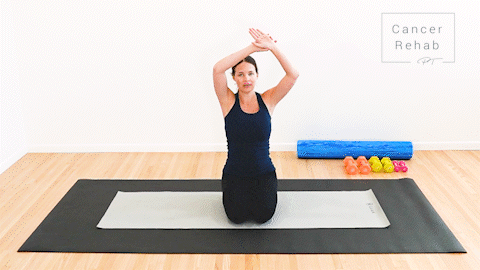
- Begin kneeling with your arms above your head.
- Grab your left wrist with your right hand.
- Gently pull your left wrist over to the side, feeling a mild stretch across the side of the body. Take a deep breath here.
- Next, you will change direction and repeat with your other arm.
- Complete back and forth 3 to 5 times.
Foam Roller Pec Stretch
For this last stretch, you will need a foam roller. I prefer a soft foam roller that is comfortable to lie on. You can also use a towel rolled longways.
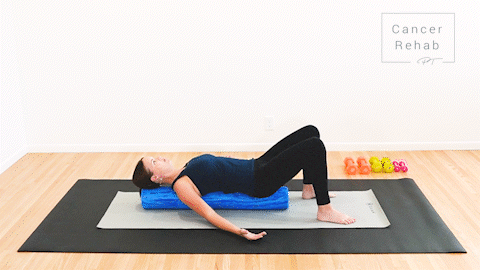
- Begin sitting close to the edge of your foam roller and gently lie back, keeping your knees bent and feet fairly wide on the ground. You should have head support.
- Keep your arms relaxed by your sides with your palms up. Allow your shoulders to gently roll over the foam roller as you open up your chest.
- In this position, focus on deep breathing, taking a few big inhales and exhales.
- Now begin to slowly slide your arms up, away from your sides. As you get comfortable, you can bring them up close to shoulder height. Your arms should still be resting on the ground with your shoulders relaxed.
- As you feel a mild stretch, pause and take a nice, big, deep breath.
- Hold this position for 20 seconds, working up to 1-2 minutes.
- Slowly bring your arms back to your sides, then slowly roll up or off to the side.
Strength
An important part of recovery is engaging in safe exercises to help rebuild the strength of muscles around the affected arm so that one can regain arm and shoulder movement.
Wall Punches
This next movement is similar to a wall push-up and focuses on shoulder movement as well as getting gentle muscle activation in the chest wall, specifically the pec area, triceps, and mid back.

- Stand facing a wall with feet slightly apart. You want to be about an arm’s length away from the wall. To make it more challenging, you can be a little further away, and if you need to modify, you can stand a little closer.
- Bring your arms up to shoulder level as you reach for the wall.
- Allow yourself to come towards the wall slowly, and then when you reach the wall, push away back to the starting position.
- When you reach the starting position, instead of stopping, you are going to push away (punch) from the wall and allow your shoulder blades to round forward, feeling a nice, mild stretch in the scapular area.
- Focus on keeping your elbows tucked into your sides to prevent chicken wings from coming out.
- Repeat 8-10 times. You may begin working up to 15-20 times, depending on where you are in your recovery journey.
Bent Over Row
For this exercise, you will grab your light weights. If you are a beginner, you may choose to go with no weight or only 1 or 2 pounds. Start light for comfort, and you can always increase weight.

- Begin standing with your feet about shoulder-width apart from each other.
- Hinge at your hips, allowing a slight bend in your knees.
- Allow your arms to hang down with elbows straight.
- Bring your elbows up straight behind you, as you squeeze your shoulder blades at the top of the movement. The focus should be on the mid-back pinch and coming out of the squeeze.
- Relax and slowly lower your arms back down.
- Repeat 8-10 times, working up to 15-20 times when you feel comfortable.
Bicep Curl
Gentle arm exercises can be very beneficial in helping someone regain normal movement. This last strength exercise is a great way to start getting activation in your biceps. It also works your pec muscles, which many people begin to notice more after surgery.
I suggest starting with a light weight, maybe even only 1 pound, and gradually increasing weight week-by-week as you feel comfortable.

- Begin in a neutral standing position, holding your light weights, with your elbows tucked in slightly in front of your sides and palms facing forward. You may also choose to do hammer curls, where your palms face inward toward your body.
- Bring the weights up for one second, elbows bent, until you feel a mild squeeze at the top.
- Come back, taking 2 to 3 seconds, nice and controlled.
- Focus on keeping your core engaged.
- Repeat 8 to 10 times.
Recovering from Breast Cancer Treatment
Right now there are more than 4 million people recovering from breast cancer in the United States. Recovering from breast cancer surgery can be a stressful period, and it is common to face additional challenges such as shoulder pain after surgery or cording in the armpit area.
The good news is that you absolutely can live a high-quality life and get back to doing the things you love. With proper treatment and guidance from your doctor, breast care nurse, or by following a breast cancer rehab program, you can begin physical activity and maintain normal movement.
Breast cancer rehabilitation programs help those recovering from cancer regain a normal quality of life by safely addressing common issues such as pain, fatigue, and swelling after surgery. Many recovery programs include physical therapy, occupational therapy, and different lifestyle modifications.
FAQs
What exercises prevent lymphedema after breast cancer?
The best exercises for preventing lymphedema are gentle strength movements, activities like walking or swimming, and light stretches. The key is getting cleared by your doctor first, then gradually adding movement you can stick with consistently.
For a more detailed guide on how to prevent lymphedema, you can read about tips and exercises from certified lymphedema specialist, Kelly Sturm.
What exercises should I avoid after breast surgery?
In these early weeks, avoid heavy lifting (usually nothing over 5-10 pounds), overhead movements that cause pain, and any activity that causes significant discomfort. Always follow your doctor’s specific restrictions – they know your individual situation best.
How soon after breast surgery can I exercise?
This varies for everyone, but typically you can start very gentle movements within the first few days after surgery (like the exercises in my 0-3 week guide). More active exercises like these usually come around 4-6 weeks post-surgery, but always wait for your doctor’s clearance.
Final Thoughts
Feeling like yourself again after breast cancer surgery is absolutely possible. I’ve seen thousands of patients get their strength and confidence back. Once your doctor clears you, start with gentle movements like these to help regain your normal movement and get back to your activities.

